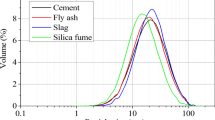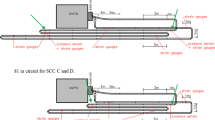Abstract
Pumping is the most utilized concrete placement technique on construction sites around the globe. Despite being used since the 1960s, a large portion of the knowledge related to the understanding of the concrete pumping process—especially with a focus on the effect of pumping on the concrete air void system—was generated through experience, and thus creating a need for a research-based approach to broaden our understanding of the process and how it affects in-place concrete properties. In this paper, three research campaigns are described. Two controlled large-scale experiments investigating both conventional concrete (CVC) and self-consolidating concrete (SCC) were conducted, in addition to a field research program where concrete pumping in real-world conditions was studied. The air void system of each pumped concrete mixture was characterized before and after pumping, both in plastic and hardened states. Additionally, concrete pressure during pumping was monitored for CVC mixtures. Lastly, Super Air Meter measurements were conducted on fresh concrete. It was shown that the characteristics of the pumping system, such as boom configuration, flow rate, or pumping pressure, do not correlate with the changes in the air void system due to pumping for CVC, however, a relationship between the change in the spacing factor and concrete flow rate was observed for SCC. Our results also indicate that the changes in the air void system induced by pumping are dependent on the particular mixture design and discharge conditions at the point of placement.











Similar content being viewed by others
References
Kosmatka SH, Wilson ML (2016) Design and control of concrete mixtures, 16th edn. Portland Cement Association, Skokie, IL
Jacobsen S, Mork JH, Lee SF, Haugan L (2008) Pumping of concrete and mortar—state of the art. sintefgroup.com, p 46
Jolin M, Chapdelaine F (2006) Pumping concrete: a fundamental and practical approach. In: Shotcrete Undergr. Support, no X, pp 334–347
Jolin M, Burns D, Bissonnette B, Gagnon F, Bolduc L (2009) Understanding the pumpability of concrete. In: Proceedings shotcrete for underground support XI
Kaplan D (2001) Pompage des bétons. PhD Dissertation, Laboratoire Central des Ponts et Chausees, Paris (in French)
Hover K (1995) Investigating effects of concrete handling on air content. Concr Constr 745–750
Pleau R, Pigeon M, Lamontagne A, Lessard M (1995) Influence of pumping on characteristics of air-void system of high-performance concrete. Transp Res Rec 1478:30–36
Yingling J, Mullings GM, Gaynor RD (1992) Loss of air content in pumped concrete. Concr Int 57–61
Macha RV, Zollinger DG, Szecsy R (1994) Examination of air entertainment stability factors of pumped concrete. Research Report FHWA/TX-93/1254-3F, Texas Transportation Institute, Austin, TX
Tennessee Department of Transportation (2003) Evaluation of the changes in air content in concrete due to pumping. Research Report, Division of Materials and Tests Research and Product Evaluation Section, Nashville, TN
Whiting DA, Nagi MA (1998) Manual on control of air content in concrete. Portland Cement Association, Skokie, IL
Feys D (2009) Rheological properties and pumping of self-compacting concrete. PhD Dissertation, Ghent University
Khatib R (2013) Analysis and prediction of pumping characteristics of high-strength self-consolidating concrete. PhD Dissertation, Universite de Sherbrooke
Pigeon M, Marchand J, Pleau R (1996) Frost resistant concrete. Constr Build Mater 10(5):339–348
Chapdelaine F (2007) Etude Fondamentale et Pratique sur le Pompage du Beton. PhD Dissertation, University of Laval (in French)
Dyer M (1991) An investigation of concrete pumping and effects of pressure on the air void system of concrete. Master Thesis, University of Washington, WA
Elkey W, Janssen DJ, Hover KC (1994) Concrete pumping effects on entrained air voids. Research Report (Project T9233, Task 21), Washington State Transportation Center (TRAC), Seattle, WA
Kaplan D, De Larrard F, Sedran T (2005) Design of concrete pumping circuit. ACI Mater J 102(2):110–117
ASTM C143/C143M-15a (2015) Standard test method for slump of hydraulic-cement concrete. ASTM International, West Conshohocken, PA
ASTM C1611/C1611M-14 (2014) Standard test method for slump flow of self-consolidating concrete. ASTM International, West Conshohocken, PA
ASTM C138/C138M-17a (2017) Standard test method for density (unit weight), yield, and air content (gravimetric) of concrete. ASTM International, West Conshohocken, PA
ASTM C1064/C1064M-12 (2012) Standard test method for temperature of freshly mixed hydraulic-cement concrete. ASTM International, West Conshohocken, PA
ASTM C231/C231M-14 (2014) Standard test method for air content of freshly mixed concrete by the pressure method. ASTM International, West Conshohocken, PA
AASHTO TP 118-15 (2015) Standard method of test for characterization of the air-void system of freshly mixed concrete by the sequential pressure method. American Association of State Highway and Transportation Officials, Washington, DC
Vosahlik J, Riding KA, Esmaeily A, Billinger R, McLeod H (2016) Effects of air void clustering on concrete compressive strength. ACI Mater J 113(6)
ASTM C457/C457M-16 (2016) Standard test method for microscopical determination of parameters of the air-void system in hardened concrete. ASTM International, West Conshohocken, PA
Powers TC, Willis TF (1949) The air requirement of frost resistant concrete. Proc Highw Res Board Res Dev Lab Portl Cem Assoc 29(33):184–211
Feys D, Khayat KH, Khatib R (2016) How do concrete rheology, tribology, flow rate and pipe radius influence pumping pressure? Cem Concr Compos 66:38–46
Acknowledgements
Authors would like to express their gratitude to Kansas Department of Transportation, ACI Concrete Placement, Fordyce Concrete Company, the RE-CAST Tier 1 UTC at Missouri S&T, The Center for Infrastructure Engineering Studies at Missouri S&T, EllisDon and Votorantim Cimentos St Marys CBM in Toronto for their support of this research study. Authors also greatly appreciate the help of Philip Zacarias and Brian Schulz of Votorantim Cimentos St Marys CBM with conducting pumping experiments in Toronto.
Funding
This study was funded by Kansas Department of Transportation (Award # K-TRAN KSU-14-2) and RE-CAST Tier 1 UTC (Grant # DTRT13-G-UTC45) at Missouri S&T. Non-financial support for this study was received from ACI Conrete Placement, Fordyce Concrete Company, EllisDon, and Votorantim Cimentos St Marys CBM.
Author information
Authors and Affiliations
Corresponding author
Ethics declarations
Conflict of interest
Kyle Riding received funding from Kansas Department of Transportation for this study. Dimitri Feys received funding from the RE-CAST Tier 1 UTC at Missouri S&T. Will Lindquist was employed by the Kansas Department of Transportation while a portion if this study was being conducted. Jan Vosahlik, Lloyd Keller, Stacia Van Zetten and Bryan Schulz declare that they have no conflict of interest.
Rights and permissions
About this article
Cite this article
Vosahlik, J., Riding, K.A., Feys, D. et al. Concrete pumping and its effect on the air void system. Mater Struct 51, 94 (2018). https://doi.org/10.1617/s11527-018-1204-1
Received:
Accepted:
Published:
DOI: https://doi.org/10.1617/s11527-018-1204-1




